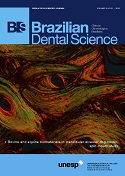Influence of the interocclusal splint in condylar position of patients with tmd: computed cone beam
DOI:
https://doi.org/10.14295/bds.2016.v19i3.1264Resumo
The aim of this study was to evaluate the condylar position in patients with intra-articular temporomandibular disorders (TMD) before and after treatment with interocclusal stabilization splint (ISS) through computerized tomography cone beams (CTCB). Twenty-two patients diagnosed with intra-articular TMD (Research Diagnostic Criteria for Temporomandibular Disorders - Group II) were submitted to the therapy with ISS during 90 days. Three CTCB exams were performed in three moments: T1 – Initial moment, before the ISS therapy, with the patient in dental occlusion; T2 (after 90 days of treatment, in occlusion on the ISS) and T3 (after 90 days of treatment, with the patient in dental occlusion). Afterwards the anterior (AS), superior (SS) and posterior articular space (PS) in sagittal sections were then measured and the data were statistically analyzed using the t-test. There was a statistically significant increase in the comparison between T1 and T2 for the AS and PS (p< 0.0001), between T3 and T2 for AS (p= 0.0008) and PS (p< 0.0001). In comparison T1/T3 there was a significant increase in AS (p= 0.01) and SS (p= 0.04), and non-significant in PS (p= 0.89). The interocclusal splint provides temporary changes in condylar position, with a tendency to increase the joint space, varying in accordance with individual characteristics. Therefore, it should not be used as a single therapy, but combined with other strategies that include the TMD multidimensionality. The interocclusal splint has proved to be reversible and conservative therapeutic modality, as it does not generate permanent changes in joint tissues.Downloads
Downloads
Arquivos adicionais
Publicado
Como Citar
Edição
Seção
Licença
TRANSFERÊNCIA DE DIREITOS AUTORAIS E DECLARAÇÃO DE RESPONSABILIDADE
Toda a propriedade de direitos autorais do artigo "____________________________________________________________________" é transferido do autor(es) para a CIÊNCIA ODONTOLÓGICA BRASILEIRA, no caso do trabalho ser publicado. O artigo não foi publicado em outro lugar e não foi submetido simultaneamente para publicação em outra revista.
Vimos por meio deste, atestar que trabalho é original e não apresenta dados manipulados, fraude ou plágio. Fizemos contribuição científica significativa para o estudo e estamos cientes dos dados apresentados e de acordo com a versão final do artigo. Assumimos total responsabilidade pelos aspectos éticos do estudo.
Este texto deve ser impresso e assinado por todos os autores. A versão digitalizada deverá ser apresentada como arquivo suplementar durante o processo de submissão.




























